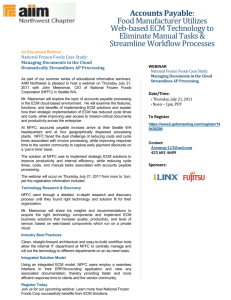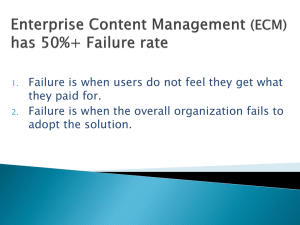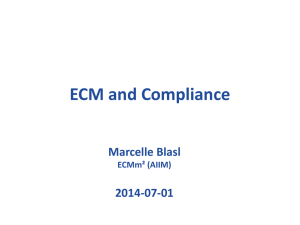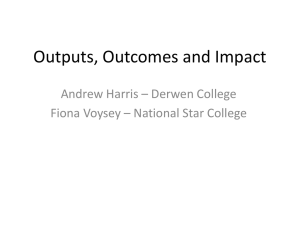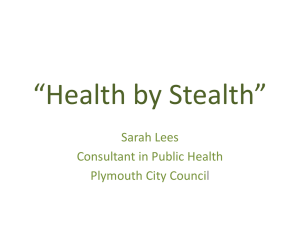- Open Research Online
advertisement
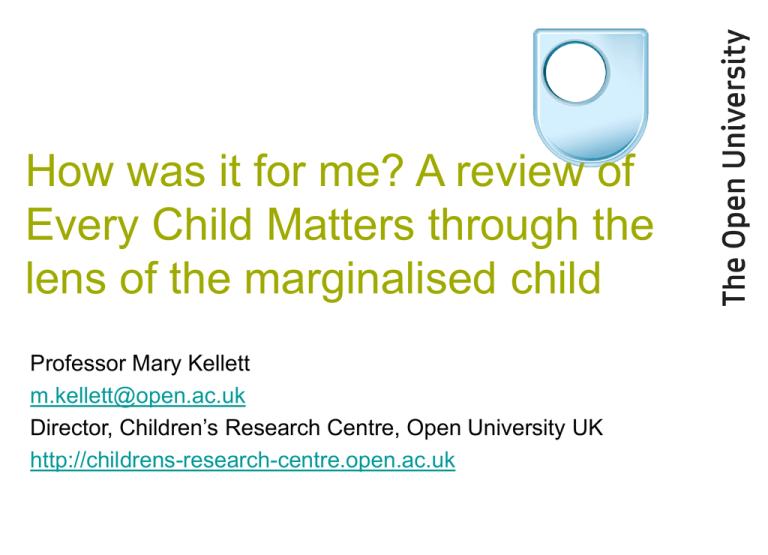
How was it for me? A review of Every Child Matters through the lens of the marginalised child Professor Mary Kellett m.kellett@open.ac.uk Director, Children’s Research Centre, Open University UK http://childrens-research-centre.open.ac.uk Introduction • ECM aimed to put the child at the centre of provision – ‘team around the child’ – attend to children’s holistic needs and emphasize wellbeing as a human right • This presentation explores ECM wellbeing indicators through the lens of marginalized children and reviews the extent to which their views are being accommodated • focuses on issues of disadvantage, diversity and marginalisation from a rights’ perspective • a few snap shots of children’s lived experiences to stimulate discussion and debate 5 ECM outcomes • • • • • Be healthy Be safe Enjoy and achieve Make a positive contribution Achieve economic wellbeing – ? How achievable are these for marginalised children Disabled children – wheelchair provision • Mobility is a vital part of childhood on any wellbeing indicator - yet • - wheelchair provision still remains problematic for many children • 70,000 children currently waiting for the right wheelchair (whizzkids.org.uk, 2011) • Many LAs will not provide a wheelchair until age 30 months (< pushchair). This denies children the right to engage in activities commensurate with development needs such as independent exploration. • ? What happened to ‘team around the child’ ? • ? What happened to ‘attending to children’s holistic needs and emphasizing wellbeing as a human right’ ? Children’s perspectives • Sam is a 4-year old with cerebral palsy. The NHS only provided him with a basic manual wheelchair for indoor use which prevented him being independent. He had to rely on a charity to acquire an appropriately adapted indoor/outdoor motorised chair equipped with a riser enabling him to maximize his independence, exploratory play and social interaction with peers. • ‘My new powered wheelchair means that I can go in the playground and not get so tired – it is fantastic! I can go shopping without someone having to push me all the time and I can play basketball at my Saturday Club all by myself.’ (10-year-old with cerebral palsy). • (Source Sharma and Morrison 2006; 2008) Children’s mental health • ‘Child and adolescent mental health services in this country are a disgrace. There are many places where the waiting list is 18 months or more. If that were an adult service there would be a public outcry’. (David Hall, president of Royal College of Paediatrics and Child Health, 2002) • Innocenti Report (UNICEF, 2007) UK was ranked bottom in children’s own subjective sense of wellbeing. • It wasn’t until 2007 that Gov agreed to phase out all admissions of children to adult psychiatric wards by 2010 • Children’s perspectives • Shaun said most of his time on the [adult] ward was spent in his room listening to music and staring at his wall, walking the corridors, eating sleeping and drinking tea. He was not offered the opportunity to take part in any activities, even though there were many on offer for [adult] patients. Shaun believes that not having anything to do contributed massively to how low he felt while being a patient. • ‘I need treatment to get over my treatment’ (Hattie, young person on adult psychiatric ward) • Source 11 Million, 2007 Barnardo’s perspectives on children’s mental health provision • Barriers: • Opaque commissioning processes and the difficulties that come with separate commissioning budgets across integrated children’s services; • Dominance of the medical model in access, diagnosis and treatment; • Overlooking the participation of children and young people in commissioning and developing services; • What’s needed: • Address continued stigma attached to mental health difficulties. • Increased strategic and financial support for early intervention and preventative approaches; • A shift in culture to embed collaborative working and knowledge sharing; • Improved information and access to services for vulnerable groups; • Source: Barnardo’s Policy and Research Unit, 2008 Some ECM positives for disadvantaged children • Sure Start children’s centres = flagship of ECM. • Accessible premises in an area of high disadvantage • Integrated childcare and learning for 0-5 year olds, 48 weeks per year, 5 days per week and 10 hours per day • Link to Jobcentre Plus to maximize employment prospects for parents • Community health facilities • Special needs and disabilities early identification and support service • Family outreach services - …. but … • This initiative is already in retreat under the Coalition Gov Integrated services at the margins • ? Services that follow the child? • Children on the margins of society are the least likely to achieve the 5 ECM outcomes. Time and again research has shown that where a child is prey to disadvantage or marginalization, poverty is one of the associated factors. Children living below the poverty line experience a poorer education, achieve less qualifications, live in substandard housing and enjoy less good health (Hirsch, 2007) • Crucially, poverty prevents them participating in social childhood activities. Tomlinson & Walker (2009) found that 16% of the poorest fifth families in England could not afford for their child to have a friend for tea once a fortnight. • Figures from the DWP (2009) revealed that 13.5 million people in the UK were in the ‘income poor’ category – this affects 1 in 6 children. The number of children in workless households rose to 1.9 million (BBC News, 2009) Young carers • Children from disadvantaged backgrounds are most likely to have carer responsibilities (Bibby and Becker, 2004) and the least likely to achieve ECM outcomes • Olu is 10 and lives with his mother who has a mental health problem. Sometimes she’s fine, but when she’s ill she becomes very depresses and hardly gets out of bed. At these times, Olu has to look after the flat, get food for himself and his mum, get to school and back on his own and deal with the things his mother can’t do, such as collecting her money and paying the rent and the bills. (www.youngcarers.net, 2010) Messages from young carers to service providers • • • • ‘introduce yourself, tell us who you are and what your job is’ ‘tell us what is going to happen next’ ‘give us as much information as you can’ ‘remember to talk to us: we have first hand experience of what is going on’ • ‘keep on talking to us and keep us informed. Tell us it’s not our fault’ • ‘tell us if there is anyone we can contact’. (Daniel, 2008: 101-2) Children of single parents • Number of children living in single-parent families has increased significantly to 3 million (Gingerbread, 2010) • single parents score highly on the child poverty indicator predictor index • Research about children living in single parent families is almost entirely adult based and adult defined (Walker et al, 2008) • Interviews with 40 children from single parent families about their experiences of service provision revealed their perceptions that the greatest support came from extended family (grandparents particularly) and friends rather than from integrated services (Walker et al, 2008) Children’s perspectives • At the weekends I go to Nanas. I sleep Saturday and Sunday night … so my mum can get some peace [Annie, aged 8] • Children talked about their parent relationship being very important but time poor because of the pressure on busy single parents juggling work and care commitments (impact of welfare to work policies) • Children identified limitations for play as a significant quality of childhood issue [lack of space at home, too far from parks and transport costs too high to get to organized leisure activities] • Healthy living – children reported their parent could only afford to put cheap food on the table and items such as fresh fruit were far too expensive Voluntary sector • Voluntary sector is particularly skilled at service provision for marginalised families due to their extensive local knowledge • In a prime position to provide quality support towards achieving the 5 ECM outcomes • Children’s experiences reveal the positive impact that many voluntary organisations have on the quality of their childhoods. Storybook dads • Established in Dartmoor prison in 2004 and has since helped over 6,000 prisoners in 70 prisons to stay connected with their children – I miss my Dad so much. When I feel lonely I listen to my CD and hearing his voice makes me feel better. – Daddy’s done a CD for me which was The Frog Prince and he did Jack and the Beanstalk for my brother. They’re both really good. He says he will do another one for us for Christmas. (www.storybookdads.co.uk) Barnardo’s Hamara family project • • • • • • • • • ‘hamara’ means ‘our’ in Urdu/Hindi Works with black and minority ethnic communities Inclusive play and holiday short break opportunities Play activities to children with life-limiting conditions Support programme for children newly diagnosed with autistic spectrum disorder Music therapy service Dad’s group Club for mothers of disabled children Crisis intervention service for vulnerable families Voluntary sector squeeze • Harder for voluntary organisations to compete on a level playing field in tendering processes • Notable shift towards short term contracts • Greater risk of being squeezed out despite being ideally placed to provide services for many of the most marginalised What can marginalized children’s experiences teach us about effective service provision? • needs-driven not resource driven (including better accommodation of voluntary sector) • holistic provision that attends to the wellbeing of the whole child • early intervention (one of the real positives of ECM has been the Sure Start children’s centres) • Effective inter-agency communication • the imperative of listening to children’s voice Messages from children about ECM and integrated services • ‘ask us what we think on our own and listen to what we say’ • ‘we want to be looked after by adults we can trust’ • ‘don’t always believe an adult over a child – ask for evidence and decide for yourself’ • ‘keeping us busy keeps us out of trouble’ • ‘when we make a complaint – sort it, not report it’ References • BBC News (2009) One in six UK homes ‘has no work’, 26 August, http://news.bbc.co.uk/1/hi/8222145.stm [accessed 17/01/11]. Sharma, N. and Morrison, J. (2008) Don’t Push Me Around: Disabled children’s experiences of wheelchair services in the UK, Ilford: Whizz-Kidz in association with Barnardos. • Barnardo’s (2008) Barnardo’s response to the CAMHS review: improving the mental health and psychological well-being of children and young people: call for evidence, http://www.barnardos.org.uk/barnardo_s_response_to_camhs_review_3rd_july_08.pdf • Daniel, G. (2008) ‘Talking with children: constructing victim-hood or agency?’, in P. Kennison and A. Goodman (eds) Children as Victims. Exeter, Learning Matters.Sharma, N. and Morrison, J. (2008) Don’t Push Me Around: Disabled Children’s Experiences of Wheelchair Services in the UK. Ilford, Whizz-Kidz/Barnardo’s. • Gingerbread (2010) Gingerbread factfile, http://www.gingerbread.org.uk/content/365/Gingerbread-Factfile • Walker, J. Crawford, J. and Taylor, F. (2008) ‘Listening to children: gaining a perspective of the experiences of poverty and social exclusion from children and young people of single-parent families’ Health and Social Care in the Community,16 (4), 429–436. • UNICEF (2007) Child Poverty in Perspective: An Overview of Child Well-being in Rich Countries. Florence, Innocenti Research Centre/UNICEF. • 11 Million (2007) Pushed into the Shadows: Young People’s Experiences of Mental Health Facilities. London, Office of the Children’s Commissioner. Children’s Perspectives of Integrated Services: Every Child Matters in Policy and Practice, Palgrave Macmillan (available late Aug 2011)

